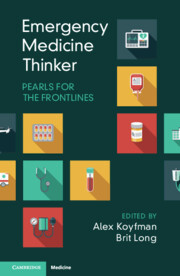Introduction
Published online by Cambridge University Press: 14 March 2025
Summary
No matter how we slice it, Emergency Medicine (EM) is a young field. In the 1960s, the U.S. public began to clamor for the need of its existence. In September 1979, it became the 23rd recognized medical specialty (note: ‘23’ is a pretty special number in sports history). In 1980, the first American Board of Emergency Medicine certification examinations were offered. In September 1989, EM received primary board status. In comparison, Internal Medicine (IM) was recognized in 1936 and Surgery in 1937. As one can imagine, as medical schools were filling their ranks, the predominant teaching faculty trained in IM and Surgery. The clinical approaches and thought processes taught across the four years were unsurprisingly IM- and Surgery-centric and mostly still are. We can all easily agree that EM calls for a different approach. The hope of this book is to explore and leave the reader with an understanding of EM decision-making and as an advocacy tool for our crucial field.
- Type
- Chapter
- Information
- Emergency Medicine ThinkerPearls for the Frontlines, pp. 1 - 2Publisher: Cambridge University PressPrint publication year: 2025

